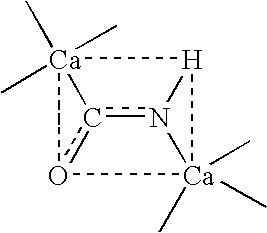Reducing the immunogenicity of fusion proteins
a fusion protein and immunogenicity technology, applied in the direction of fusion polypeptides, peptide/protein ingredients, dna/rna fragmentation, etc., can solve the problems of induction of t-cell and b-cell responses, and limited effectiveness of therapeutic proteins, so as to reduce immunogenicity
- Summary
- Abstract
- Description
- Claims
- Application Information
AI Technical Summary
Benefits of technology
Problems solved by technology
Method used
Image
Examples
example 1
Deduction of Immunogenic Reactive Epitopes of huKS-IL2 Immunocytokine
[0068] HuKS-IL2 consists of humanized VH and VL regions combined with human H and L chain constant regions. The H chain was fused at its carboxyl terminus to the mature sequence of human IL-2 as described previously. This H chain is of the γ1 isotype and has high affinity for Fc receptors. Because of this high affinity HuKS-IL2 was cleared quickly from the circulation. Without wishing to be bound by theory, the clearance of HuKS-IL2 presumably occurs via FcR-bearing cells in the liver (Kupffer cells) and spleen (antigen presenting cells).
[0069] It was previously established that certain patients had made immune responses to some portion of the huKS-IL2 molecule, however, the epitopes recognized by these antibodies are not known. To deduce the reactive epitopes, relative reactivities of patient sera with huKS-IL2 were compared to other related proteins:
[0070] (1) Hu14.18-IL2, a molecule with completely different ...
example 2
Modification of Amino Acid Residues at the Junction of an Antibody-Cytokine Fusion Protein to Reduce Immunogenicity by Elimination of MHC Class II Binding Motifs
[0081] Peptide threading analysis identified two overlapping peptide segments with strong MHC binding potential at the junction between the Fc and IL2 portion of the immunocytokine. The peptide threading and identification of potential T-cell epitopes was performed as disclosed in Carr (WO00 / 34317). Amino acid changes were introduced such that the existing potential MHC Class II binding epitopes were eliminated, but new potential MHC Class II epitopes were not introduced.
[0082] Modification of a junction sequence LSLSPGK-AP (SEQ ID NO: 17) to ATATPGA-AP (SEQ ID NO: 18)(“LSLS to ATAT”), where the hyphen is the immunocytokine huKS-IL2 junction, made junction-derived peptide sequences incapable of binding to any human MHC Class II with an affinity high enough to result in imnnunogenicity.
example 3
Modification of Amino Acid Residues at the Junction of Immunocytokine Fusion Proteins to Reduce Immunogenicity
[0083] Modification of a junction sequence LSLSPGK-AP(SEQ ID NO: 17) to LNLSPGA-AP (SEQ ID NO: 19)(“LSLS to LNLS”), where the hyphen is the inmmunocytokine huKS-IL2 junction, results in junction-derived peptide sequences that are still capable of binding to certain MHC Class II molecules. However, when the KS-IL2 protein is expressed in mammalian cells and secreted, the protein is N-glycosylated near the junction because of the NXS / T sequence.
[0084] The resulting junction-derived peptides are not effective as T-cell epitopes, because when the junction-derived peptides are presented to T cells by MHC Class II, the large N-glycosylation moiety prevents specific docking between a T cell-receptor and MHC Class II.
PUM
| Property | Measurement | Unit |
|---|---|---|
| binding affinity | aaaaa | aaaaa |
| hydrophobic | aaaaa | aaaaa |
| structure-based | aaaaa | aaaaa |
Abstract
Description
Claims
Application Information
 Login to View More
Login to View More - R&D
- Intellectual Property
- Life Sciences
- Materials
- Tech Scout
- Unparalleled Data Quality
- Higher Quality Content
- 60% Fewer Hallucinations
Browse by: Latest US Patents, China's latest patents, Technical Efficacy Thesaurus, Application Domain, Technology Topic, Popular Technical Reports.
© 2025 PatSnap. All rights reserved.Legal|Privacy policy|Modern Slavery Act Transparency Statement|Sitemap|About US| Contact US: help@patsnap.com

